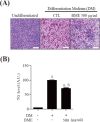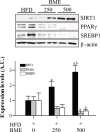Anti-obesity Activity of Ethanol Extract from Bitter Melon in Mice Fed High-Fat Diet
- PMID: 31321353
- PMCID: PMC6635615
- DOI: 10.12717/DR.2019.23.2.129
Anti-obesity Activity of Ethanol Extract from Bitter Melon in Mice Fed High-Fat Diet
Abstract
In many cases, obesity is associated with metabolic disorders. Recently, natural compounds that may be beneficial for improving obesity have received increasing attention. Bitter melon has received attention as a diabetes treatment. NAD+-dependent deacetylase (Sirtuin 1, SIRT1) has emerged as a novel therapeutic target for metabolic diseases. In this study, ethanol extract of bitter melon (BME) suppressed adipocyte differentiation and significantly increased the expression of SIRT1 in fully differentiated 3T3-L1 cells. Moreover, it enhanced the activation of AMP-activated protein kinase (AMPK). In high-fat diet (HFD)-fed induced-obesity mice, BME suppressed HFD-induced increases in body weight and white adipose tissue (WAT) weight. BME also increased the expression of SIRT1 and suppressed peroxisome proliferator-activated receptor and sterol regulatory element binding protein 1 expressions of WAT from HFD-fed mice. These findings suggest that BME prevents obesity by activating the SIRT1 and AMPK pathway and that it may be a useful dietary supplement for preventing obesity.
Keywords: 3T3-L1; Bitter melon; High-fat diet; Obesity; Sirtuin 1.
Figures





Similar articles
-
Anti-diabetic Effects of Ethanol Extract from Bitter Melon in Mice Fed a High-fat Diet.Dev Reprod. 2017 Sep;21(3):259-267. doi: 10.12717/DR.2017.21.3.259. Epub 2017 Sep 30. Dev Reprod. 2017. PMID: 29082341 Free PMC article.
-
Viola mandshurica ethanolic extract prevents high-fat-diet-induced obesity in mice by activating AMP-activated protein kinase.Environ Toxicol Pharmacol. 2014 Jul;38(1):41-50. doi: 10.1016/j.etap.2014.04.028. Epub 2014 May 5. Environ Toxicol Pharmacol. 2014. PMID: 24879516
-
Gynostemma Pentaphyllum Extract Ameliorates High-Fat Diet-Induced Obesity in C57BL/6N Mice by Upregulating SIRT1.Nutrients. 2019 Oct 15;11(10):2475. doi: 10.3390/nu11102475. Nutrients. 2019. PMID: 31618980 Free PMC article.
-
Antiobesity activity of Vigna nakashimae extract in high-fat diet-induced obesity.Biosci Biotechnol Biochem. 2013;77(2):332-8. doi: 10.1271/bbb.120755. Epub 2013 Feb 7. Biosci Biotechnol Biochem. 2013. PMID: 23391927
-
Beneficial role of bitter melon supplementation in obesity and related complications in metabolic syndrome.J Lipids. 2015;2015:496169. doi: 10.1155/2015/496169. Epub 2015 Jan 12. J Lipids. 2015. PMID: 25650336 Free PMC article. Review.
Cited by
-
Mexican Plants Involved in Glucose Homeostasis and Body Weight Control: Systematic Review.Nutrients. 2023 Apr 25;15(9):2070. doi: 10.3390/nu15092070. Nutrients. 2023. PMID: 37432178 Free PMC article.
References
-
- Baur JA, Pearson KJ, Price NL, Jamieson HA, Lerin C, Kalra A, Prabhu VV, Allard JS, Lopez-Lluch G, Lewis K, Pistell PJ, Poosala S, Becker KG, Boss O, Gwinn D, Wang M, Ramaswamy S, Fishbein KW, Spencer RG, Lakatta EG, Le Couteur D, Shaw RJ, Navas P, Puigserver P, Ingram DK, de Cabo R, Sinclair DA. Resveratrol improves health and survival of mice on a high-calorie diet. Nature. 2006;444:337–342. doi: 10.1038/nature05354. - DOI - PMC - PubMed
-
- Chen PH, Chen GC, Yang MF, Hsieh CH, Chuang SH, Yang HL, Kuo YH, Chyuan JH, Chao PM. Bitter melon seed oil-attenuated body fat accumulation in diet-induced obese mice is associated with cAMP-dependent protein kinase activation and cell death in white adipose tissue. J Nutr. 2012;142:1197–1204. doi: 10.3945/jn.112.159939. - DOI - PubMed
-
- Chen Q, Li ET. Reduced adiposity in bitter melon Momordica charantia fed rats is associated with lower tissue triglyceride and higher plasma catecholamines. Br J Nutr. 2005;93:747–754. - PubMed
-
- Fuangchan A, Sonthisombat P, Seubnukarn T, Chanouan R, Chotchaisuwat P, Sirigulsatien V, Ingkaninan K, Plianbangchang P, Haines ST. Hypoglycemic effect of bitter melon compared with metformin in newly diagnosed type 2 diabetes patients. J Ethnopharmacol. 2011;134:422–428. doi: 10.1016/j.jep.2010.12.045. - DOI - PubMed
LinkOut - more resources
Full Text Sources
Other Literature Sources
Research Materials

